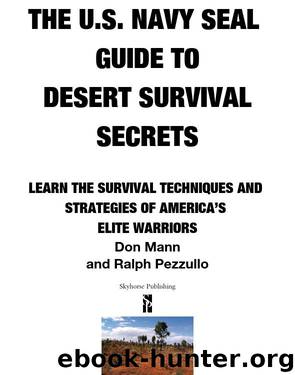U.S. Navy SEAL Guide to Desert Survival Secrets by Don Mann

Author:Don Mann
Language: eng
Format: epub
Publisher: Skyhorse Publishing, Inc.
Published: 2012-09-06T04:00:00+00:00
Treating Larger Quantities of Water
A teaspoon of bleach will treat about 7 ½ gallons of clear water or four gallons of dirty water.
A tablespoon of bleach will treat about twenty gallons of clear water or about ten gallons of dirty water.
A quarter cup of bleach treats about ninety gallons of clear water or forty-five gallons of dirty water.
Warning—Water from Natural Sources
During the past several years, increasing numbers of people have been stricken with waterborne diseases due to drinking water straight from natural sources—streams, springs, ponds, or lakes. Even though the water appears to be sparkling clean and pure, it may contain microorganisms which cause disease.
Two organisms found in many water sources are Giardia lamblia and Cryptosporidium parvum. These parasites have been found in many wild and domestic animals and can be present even in very remote areas with no sign of human life. These organisms are transferred between animals and humans by means of excreted fecal material.
Drinking water containing these parasites can cause Giardiasis or Cryptosporidiosis. Both are severe gastrointestinal disorders, which can result in diarrhea, headache, abdominal cramps, nausea, vomiting, and fever. People with degraded immune systems should be aware that a Cryptosporidium infection can be life-threatening.
To prevent infection from Giardia or Cryptosporidium, do not drink naturally occurring water before you disinfect it. Either drink the water you carry in or disinfect all water from natural sources before drinking.
The minimum water consumption rate is two gallons a day per person in the 110- to 120-degree summer temperatures. In such extreme heat, I’d say that survival time without water would be limited to around two days, maybe less, depending on the variables mentioned above.
When it comes to water sources, don’t assume that the creek, spring, or water hole you noticed on the map is going to even exist, especially during a season of drought. Talk to the folks who are out on the land all the time—the locals in the area—and find out what the water conditions are really like in the backcountry.
On an extended desert trip, and certainly in a survival situation, it’s important to know how to locate water.
Being able to read the nuances of the land is a skill of visual acuity. You’re searching for subtle clues written across the terrain that may indicate water. This is a skill that comes with experience.
Places to Look for Water
Shady areas at the base of cliffs
Rock pockets and depressions
Tree cavities and hollows
Undercut banks in dry riverbeds
Where insect life abounds
Animal tracks and bird signs
Where vegetation abounds: willows, palm trees, and cottonwood trees are water-loving trees found in proximity to either surface or subterranean water.
Download
This site does not store any files on its server. We only index and link to content provided by other sites. Please contact the content providers to delete copyright contents if any and email us, we'll remove relevant links or contents immediately.
The Vikings: Conquering England, France, and Ireland by Wernick Robert(79184)
Ali Pasha, Lion of Ioannina by Eugenia Russell & Eugenia Russell(39931)
The Vikings: Discoverers of a New World by Wernick Robert(36828)
The Conquerors (The Winning of America Series Book 3) by Eckert Allan W(36709)
Cecilia; Or, Memoirs of an Heiress — Volume 1 by Fanny Burney(32081)
Cecilia; Or, Memoirs of an Heiress — Volume 3 by Fanny Burney(31471)
Cecilia; Or, Memoirs of an Heiress — Volume 2 by Fanny Burney(31425)
Empire of the Sikhs by Patwant Singh(22778)
Hans Sturm: A Soldier's Odyssey on the Eastern Front by Gordon Williamson(18334)
The Secret History by Donna Tartt(18237)
Cat's cradle by Kurt Vonnegut(14785)
Sapiens: A Brief History of Humankind by Yuval Noah Harari(14002)
Pimp by Iceberg Slim(13809)
Talking to Strangers by Malcolm Gladwell(12906)
Norse Mythology by Gaiman Neil(12868)
Leonardo da Vinci by Walter Isaacson(12821)
Underground: A Human History of the Worlds Beneath Our Feet by Will Hunt(11850)
4 3 2 1: A Novel by Paul Auster(11823)
The Radium Girls by Kate Moore(11642)
